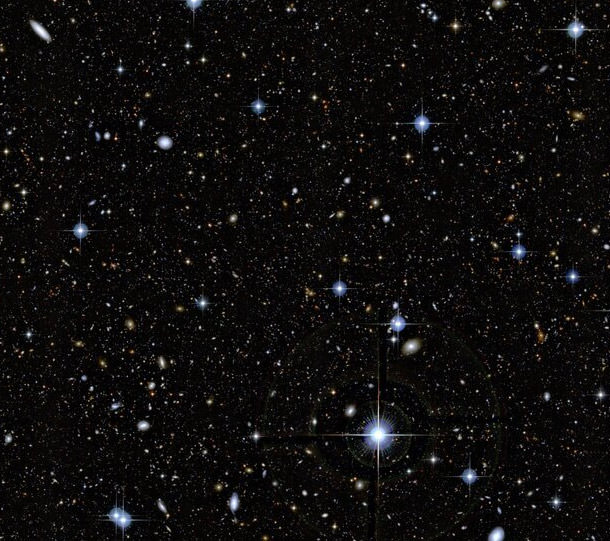Move over, Hubble Deep Field. The Canada-France-Hawaii Telescope has released a new deep-field image of as many as 500,000 galaxies out to a distance of 7 billion light years. And you can surf the entire image at high resolution with an interactive zoom feature at the CFHT website.
This new image is the result of the accumulation of several hundreds of hours of light integration over five years (2003-2008) with the CFHT using the 340 megapixel camera called MegaCam. This field and three more like it from other parts of the sky were systematically observed every three nights to detect faint supernovae going off in distant galaxies to study the effect of the mysterious dark energy responsible for the observed accelerating expansion of the universe.
Stacking these individual MegaCam images reveals a dense wallpaper of distant galaxies. An observing technique called “dithering” allows coverage of a larger field of view than that of the camera itself, leading to a sky coverage over 370 megapixels. Approximately half a million galaxies can be counted on the entire image.
As it covers a full square degree of sky (about 5 times greater than the size of the full moon), the entire image is impressive enough. But the ultra-high resolution of the image, along with a nifty interactive tool on the CFHT website, allows you to zoom in on tiny subsets of the image to see an astonishing assortment of galaxies out to a distance of 7 billion light years, about half-way to the edge of the observable universe. A few foreground stars of our own galaxy are visible. But almost everything else you see in this image is a distant galaxy.
You can access the image and the interactive viewer at the CFHT website.
Source: Canada-France-Hawaii Telescope


Oh God, that makes me feel so very small
Ditto SZ… WOW…
When I take in the Hubble deep field at 13 billion years ago and now this view at 7 billion and NOW looking at our local backyard, I’m having a tough time seeing any indication of structural transitioning. Am I not seeing the forest for the trees? Whats more, am I making sense?
I guess what I am asking is this; if the BB occurred at 14by ago, then there is only ~1by beyond the the faintest red objects in the Hubble deep field to discover/see any indication of how we got into this mess. Is this the point where the photons are stretched beyond our spectral detection capability or as they say in the medical profession, flat lined? If this be the case, then we’ll never know. How depressing, especially this time of the year.
Yes indeed we are just a spec of dust!
Please be humble of being part of this
grand sheme?
If this does not make you very, very small,
than what will?